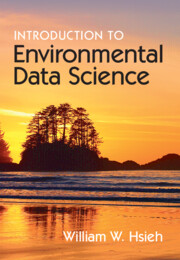Refine search
Actions for selected content:
36 results
Introduction
-
- Book:
- The Kuroshio Frontier
- Published online:
- 11 October 2025
- Print publication:
- 23 October 2025, pp 1-22
-
- Chapter
-
- You have access
- Open access
- HTML
- Export citation
Classification-informed estimation: the role of water-type clustering to improve neural network generalization for salinity and temperature estimation in coastal waters
-
- Journal:
- Environmental Data Science / Volume 4 / 2025
- Published online by Cambridge University Press:
- 04 June 2025, e32
-
- Article
-
- You have access
- Open access
- HTML
- Export citation
The challenge of land in a neural network ocean model
-
- Journal:
- Environmental Data Science / Volume 3 / 2024
- Published online by Cambridge University Press:
- 02 January 2025, e40
-
- Article
-
- You have access
- Open access
- HTML
- Export citation
Managing plastic pollution in the Arctic ocean: An integrated quantitative flux estimate and policy study
-
- Journal:
- Polar Record / Volume 59 / 2023
- Published online by Cambridge University Press:
- 10 November 2023, e36
-
- Article
-
- You have access
- Open access
- HTML
- Export citation
Spatial–temporal variability of phytoplankton community and potentially harmful species in the Golden Horn Estuary (Sea of Marmara, Türkiye)
-
- Journal:
- Journal of the Marine Biological Association of the United Kingdom / Volume 103 / 2023
- Published online by Cambridge University Press:
- 24 July 2023, e56
-
- Article
- Export citation

Blue Humanities
- Storied Waterscapes in the Anthropocene
-
- Published online:
- 14 July 2023
- Print publication:
- 10 August 2023
-
- Element
- Export citation

Introduction to Environmental Data Science
-
- Published online:
- 23 March 2023
- Print publication:
- 23 March 2023
A sensitivity analysis of a regression model of ocean temperature
-
- Journal:
- Environmental Data Science / Volume 1 / 2022
- Published online by Cambridge University Press:
- 30 August 2022, e11
-
- Article
-
- You have access
- Open access
- HTML
- Export citation
GLOBAL OCEAN RADIOCARBON PROGRAMS
-
- Journal:
- Radiocarbon / Volume 64 / Issue 4 / August 2022
- Published online by Cambridge University Press:
- 21 April 2022, pp. 675-687
- Print publication:
- August 2022
-
- Article
-
- You have access
- Open access
- HTML
- Export citation
Inertia-gravity waves and geostrophic turbulence
-
- Journal:
- Journal of Fluid Mechanics / Volume 920 / 10 August 2021
- Published online by Cambridge University Press:
- 04 June 2021, F1
-
- Article
-
- You have access
- HTML
- Export citation
4 - Do-It-Yourself Climate Change Science
-
- Book:
- Drought, Flood, Fire
- Published online:
- 01 June 2021
- Print publication:
- 27 May 2021, pp 59-91
-
- Chapter
- Export citation
Horizontal and vertical distribution of cephalopod paralarvae in the Mesoamerican Barrier Reef System
-
- Journal:
- Journal of the Marine Biological Association of the United Kingdom / Volume 100 / Issue 6 / September 2020
- Published online by Cambridge University Press:
- 03 September 2020, pp. 927-937
-
- Article
- Export citation
Dissolved inorganic Radiocarbon content of the Western Coral sea: Implications for Intermediate and Deep Water Circulation
-
- Journal:
- Radiocarbon / Volume 61 / Issue 6 / December 2019
- Published online by Cambridge University Press:
- 21 November 2019, pp. 1685-1696
- Print publication:
- December 2019
-
- Article
- Export citation
Chapter 16 - The Past and Future Ecologies of Australasian Kelp Forests
-
-
- Book:
- Interactions in the Marine Benthos
- Published online:
- 07 September 2019
- Print publication:
- 29 August 2019, pp 414-430
-
- Chapter
- Export citation
The role of cryptic dispersal in shaping connectivity patterns of marine populations in a changing world
-
- Journal:
- Journal of the Marine Biological Association of the United Kingdom / Volume 98 / Issue 4 / June 2018
- Published online by Cambridge University Press:
- 02 March 2017, pp. 647-655
-
- Article
- Export citation
Changes in the source of nutrients associated with oceanographic dynamics offshore southern Chile (41°S) over the last 25,000 years
-
- Journal:
- Quaternary Research / Volume 80 / Issue 3 / November 2013
- Published online by Cambridge University Press:
- 20 January 2017, pp. 495-501
-
- Article
- Export citation
Bomb Radiocarbon and the Hawaiian Archipelago: Coral, Otoliths, and Seawater
-
- Journal:
- Radiocarbon / Volume 58 / Issue 3 / September 2016
- Published online by Cambridge University Press:
- 17 May 2016, pp. 531-548
- Print publication:
- September 2016
-
- Article
- Export citation
Oceanographic scenario and fish larval distribution off Guinea-Bissau (north-west Africa)
-
- Journal:
- Journal of the Marine Biological Association of the United Kingdom / Volume 95 / Issue 3 / May 2015
- Published online by Cambridge University Press:
- 17 December 2014, pp. 435-452
-
- Article
- Export citation
Bedgap: where next for Antarctic subglacial mapping?
-
- Journal:
- Antarctic Science / Volume 26 / Issue 6 / December 2014
- Published online by Cambridge University Press:
- 13 November 2014, pp. 742-757
-
- Article
-
- You have access
- Open access
- HTML
- Export citation
Post-breeding at-sea movements of three central-place foragers in relation to submesoscale fronts in the Southern Ocean around Bouvetøya
-
- Journal:
- Antarctic Science / Volume 26 / Issue 5 / October 2014
- Published online by Cambridge University Press:
- 29 May 2014, pp. 533-544
-
- Article
- Export citation





